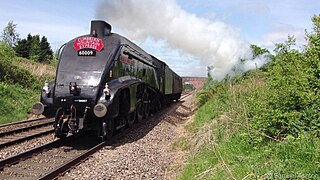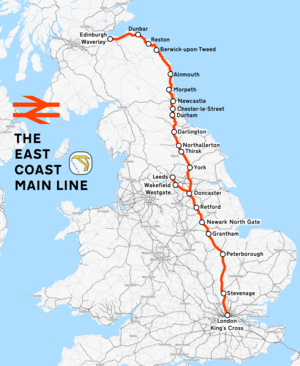
The LNER Class A4 is a class of streamlined 4-6-2 steam locomotive designed by Nigel Gresley for the London and North Eastern Railway in 1935. Their streamlined design gave them high-speed capability as well as making them instantly recognisable, and one of the class, 4468 Mallard, holds the record as the world's fastest steam locomotive. Thirty-five of the class were built to haul express passenger trains on the East Coast Main Line route from London Kings Cross via York to Newcastle, and later via Newcastle to Edinburgh, Scotland. They remained in service on the East Coast Main Line until the early 1960s when they were replaced by Deltic diesel locomotives; they themselves proving to be worthy successors to the A4s. Several A4s saw out their remaining days until 1966 in Scotland, particularly on the Aberdeen – Glasgow express trains, for which they were used to improve the timing from 3.5 to 3 hours.

A tender or coal-car is a special rail vehicle hauled by a steam locomotive containing its fuel and water. Steam locomotives consume large quantities of water compared to the quantity of fuel, so their tenders are necessary to keep them running over long distances. A locomotive that pulls a tender is called a tender locomotive. Locomotives that do not have tenders and carry all their fuel and water on board are called tank locomotives or tank engines.

The British Rail Class 55, also known as a Deltic, or English Electric Type 5, is a class of diesel locomotive built in 1961 and 1962 by English Electric for British Railways. Twenty-two locomotives were built, designed for the high-speed express passenger services on the East Coast Main Line (ECML) between Edinburgh and London King's Cross. They gained the name "Deltic" from the prototype locomotive, DP1 Deltic, which in turn was named after its Napier Deltic power units.

The East Coast Main Line (ECML) is a 393-mile long (632 km) electrified railway between its northern terminus at Edinburgh Waverley and southern terminus at London King's Cross. The key towns and cities of Peterborough, Doncaster, York, Darlington, Durham and Newcastle are on the line. The line is a key transport artery on the eastern side of Great Britain running broadly parallel to the A1 road. The main line acts as a 'spine' for several diverging branches, serving destinations such as Cambridge, Leeds, Hull, Sunderland and Lincoln, all with direct services to London. In addition, a few ECML services extend beyond Edinburgh to serve other Scottish destinations, such as Stirling, Inverness, Dundee, or Aberdeen.

LNER Class A4 4468 Mallard is a 4-6-2 ("Pacific") steam locomotive built in 1938 for operation on the London and North Eastern Railway (LNER) at Doncaster Works to a design of Nigel Gresley. Its streamlined, wind tunnel tested design allowed it to haul long distance express passenger services at high speeds. On 3 July 1938, Mallard broke the world speed record for steam locomotives at 126 mph (203 km/h), which still stands today.

60009 Union of South Africa is a LNER Class A4 steam locomotive built at Doncaster Works on 16 April 1937. It is one of six surviving A4s. Its mainline certification expired in April 2020. As the locomotive is subject to a boiler inspection, it was moved to the East Lancashire Railway as the original plan was to keep it running there until the end of boiler certificate and then send it somewhere else for static display, but a cracked boiler tube forced it into retirement prematurely. It was briefly renamed Osprey during part of the 1980s and 1990s due to political opposition against apartheid in South Africa at the time.

The Silver Jubilee was a named train of the London and North Eastern Railway (LNER) that ran between 1935 and 1939.

No. 4472 Flying Scotsman is a LNER Class A3 4-6-2 "Pacific" steam locomotive built in 1923 for the London and North Eastern Railway (LNER) at Doncaster Works to a design of Nigel Gresley. It was employed on long-distance express passenger trains on the East Coast Main Line by LNER and its successors, British Railways' Eastern and North Eastern Regions, notably on The Flying Scotsman service between London King's Cross and Edinburgh Waverley after which it was named.

The Flying Scotsman is an express passenger train service that operates between Edinburgh and London, the capitals respectively of Scotland and England, via the East Coast Main Line. The service began in 1862 as the Special Scotch Express until it was officially adopted in 1924. It is currently operated by London North Eastern Railway.

The London and North Eastern Railway (LNER) Class V2 2-6-2 steam locomotives were designed by Sir Nigel Gresley for express mixed traffic work, and built at the LNER shops at Doncaster and Darlington between 1936 and 1944. The best known is the first of the class, 4771 Green Arrow, which is the sole survivor of the class.

4464Bittern is a London and North Eastern Railway (LNER) Class A4 steam locomotive. Built for the LNER and completed on 18 December 1937 at Doncaster Works as works number 1866, it received number 4464. After that it was renumbered 19 on 16 August 1946 under the LNER 1946 renumbering scheme, and finally 60019 by British Railways on 10 October 1948, after nationalisation. Of the 35 strong class, it is one of six to survive into preservation but it is one of only two currently scheduled to be certified for mainline use.

The London and North Eastern Railway Gresley Classes A1 and A3 locomotives represented two distinct stages in the history of the British 4-6-2 "Pacific" steam locomotives designed by Nigel Gresley. They were designed for main line passenger services and later express passenger services, initially on the Great Northern Railway (GNR), a constituent company of the London and North Eastern Railway after the amalgamation of 1923, for which they became a standard design. The change in class designation to A3 reflected the fitting to the same chassis of a higher pressure boiler with a greater superheating surface and a small reduction in cylinder diameter, leading to an increase in locomotive weight. Eventually all of the A1 locomotives were rebuilt, most to A3 specifications, but no. 4470 was completely rebuilt as Class A1/1.

Doncaster Railway Works is a railway workshop located in Doncaster, England.

Elizabethan Express is a 1954 British Transport Film that follows The Elizabethan, a non-stop British Railways service from London King's Cross to Edinburgh Waverley along the East Coast Main Line. Although originally intended as an advertising short, it now acts as a nostalgic record of the halcyon years of steam on British Railways and the ex LNER Class A4.

The Race to the North was the name given by the press to occasions in two summers of the late 19th century when British passenger trains belonging to different companies would literally race each other from London to Edinburgh over the two principal rail trunk routes connecting the English capital city to Scotland – the West Coast Main Line which runs from London Euston via Crewe and Carlisle and the East Coast Main Line route from London King's Cross via York and Newcastle. The "races" were never official and publicly the companies denied that what happened was racing at all. Results were not announced officially and the outcomes have since been hotly debated. In the 20th century there were also occasions of competition for speed on the two routes.

LNER Peppercorn Class A1 No. 60163 Tornado is a 4-6-2 steam locomotive completed in 2008 to an original design by Arthur Peppercorn. It is the first new build British mainline steam locomotive since 1960, and the only Peppercorn Class A1 in existence after the original batch were scrapped. In 2017, Tornado became the first steam locomotive to officially reach 100 mph (160 km/h) on British tracks in over 50 years.
The history of rail transport in Great Britain 1923–1947 covers the period when the British railway system was run by the Big Four group of companies – the London, Midland and Scottish Railway (LMS); the Great Western Railway (GWR); the London and North Eastern Railway (LNER); and the Southern Railway (SR). The period includes the investment following World War I; the rise in competition from the roads in the 1920s; development of steam locomotives capable of sustained 100 mph (160 km/h) running; the Great Depression of the 1930s; World War II and its aftermath; and the lead up to nationalisation during 1947.

The Race to the North is an episode of Top Gear that featured a three-way race held in 2009 between a Jaguar XK120 car, a Vincent Black Shadow motorcycle, and railway locomotive 60163 Tornado – a brand new mainline steam engine completed in Britain in 2008. The race saw the car, bike and locomotive, race from London, England, to Edinburgh, Scotland, a journey of around 400 miles (640 km). Eighteen months in the planning, the race was filmed in secret on 25 April 2009, and shown on 21 June 2009 as the first episode of the thirteenth series of Top Gear

Danby Wiske railway station was a station on the East Coast Main Line. It was located approximately 0.5 miles (0.8 km) east of Danby Wiske, in North Yorkshire. Opened on 1 December 1884 the station was closed to passengers on 15 September 1958.

LNER Class A3 2750 Papyrus was a 4-6-2 "Pacific" steam locomotive built for the London and North Eastern Railway (LNER) at Doncaster Works to a design of Nigel Gresley, entering service in March 1929. Primarily used to haul express passenger trains on the East Coast Main Line by LNER and its successor, British Railways, it is notable for achieving what was at the time a world record-breaking speed for a steam locomotive of 108 mph on 5 March, 1935. A fictionalized account based on the locomotive's service history and speed record, 2750: Legend of a Locomotive by H.C. Webster, was published in 1953 and reprinted in 2016.





















